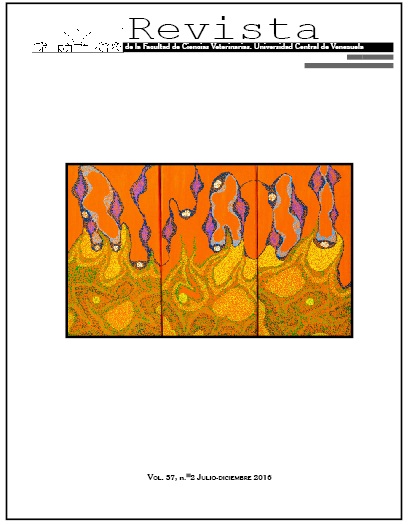Consanguinidad y su Efecto Sobre Caracteres de Crecimiento en Cinco Rebaños de Ganado Brahman Registrado en Venezuela
Contenido principal del artículo
Resumen
Un total de 27098 datos provenientes de cinco rebaños de ganado Brahman registrado en Venezuela, fueron utilizados para evaluar los niveles de consanguinidad a lo largo del periodo 2001 a 2012 y sus posibles efectos negativos sobre los caracteres peso al nacer, 205 y 548 d. Se utilizó un modelo lineal que incluía, además de la covariable nivel de consanguinidad, los efectos de año y mes de nacimiento, sexo y edad de madre al parto. El promedio global de consanguinidad fue de 0,574%, con fluctuaciones entre 0,37 y 2,20 para los rebaños, mientras que los promedios de los consanguíneos fluctuaron entre 0,95 y 4,53%. Menos del 2,5% de los animales en los rebaños presentaron valores superiores a 12,8%. No se detectó una tendencia al incremento de la consanguinidad con los años. Los promedios ponderados señalaron regresiones negativas de -68,4; -283,3 y -614,6 g por cada 1% de incremento en consanguinidad, que se traduce en pérdidas de 39, 163 y 352 g por animal al nacer, 205 y 548 d de edad, respectivamente. Se concluye la necesidad de mantener programas permanentes de organización de apareamientos en los rebaños para minimizar el efecto de la consanguinidad.
Abstract
Some 27098 individual records from five registered Brahman herds in Venezuela, were analyzed with a general lineal model in order to evaluate inbreeding levels for the period 2001 to 2012 and its possible negative effects on weight at time of birth, 205 days and 548 days of age. Besides inbreeding value, year and month of birth, sex and mother age were included in the model. General average of inbreeding was 0.574%, with a range from 0.37 to 2.20 for individual herds. Inbred animals averaged from 0.95 to 4.53%. Less than 2.5% of the animals in the herds showed values higher than 12.8%. It was not detected any important increment of inbreeding value with time. Weighted averages showed negative regressions of – 68.4, - 283.3 and – 614.6 gr associated with an increment of 1% of inbreeding, which means loss of 39, 163 and 352 gr by animal at birth, 205 days and 548 days of age, respectively. It is concluded that permanent mating programs in the herds must be maintained in order to minimize inbreeding effects.

